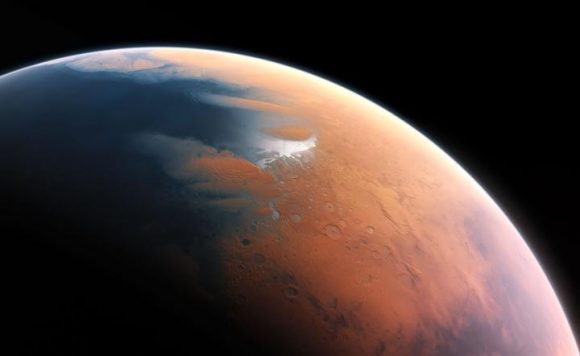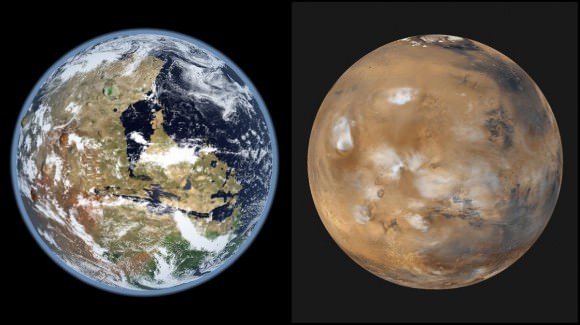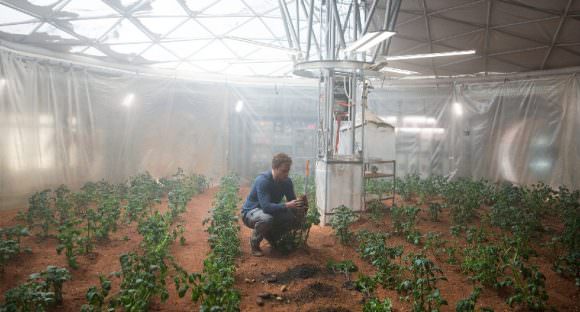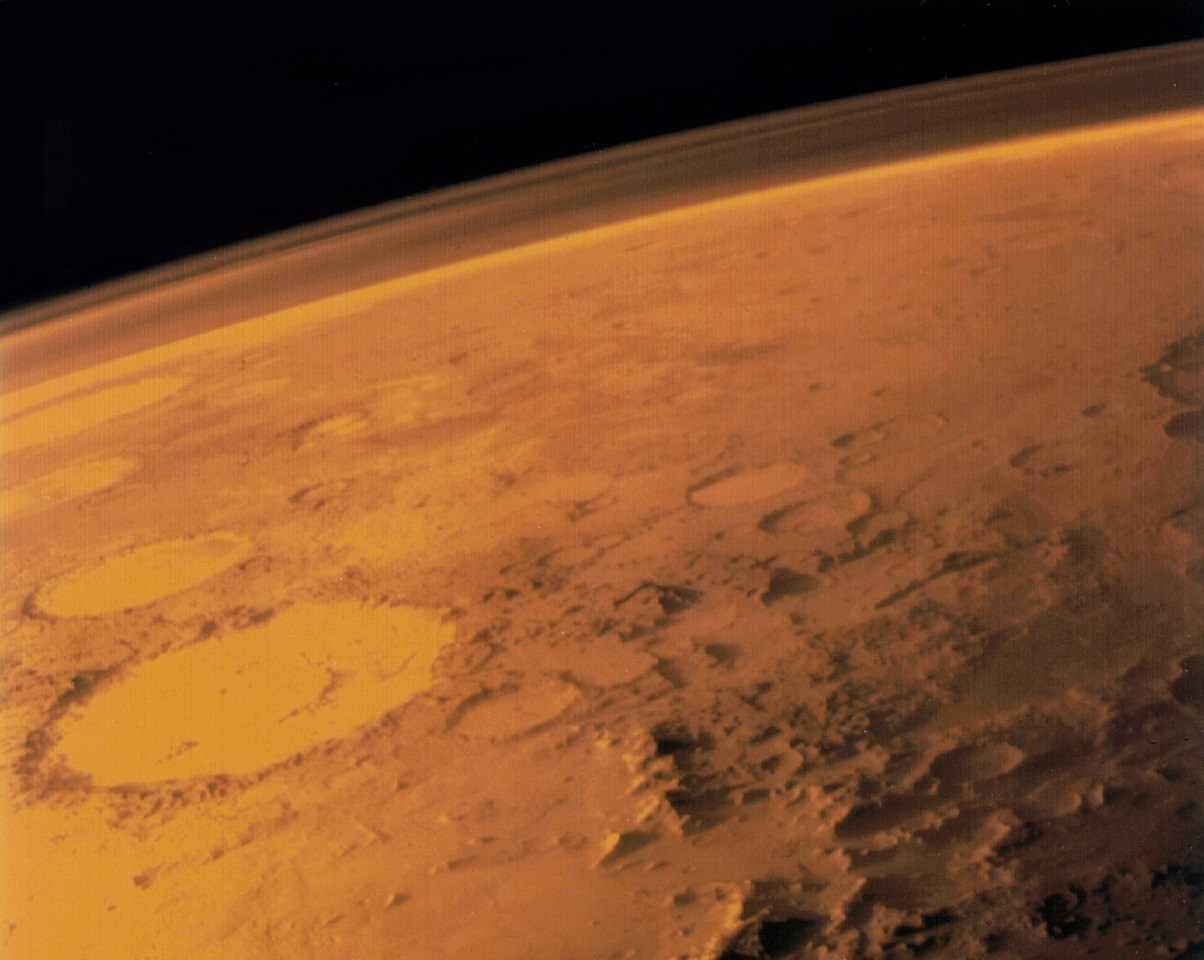One of the most significant finds to come from our ongoing exploration and research efforts of Mars is the fact that the planet once had a warmer, wetter environment. Between 4.2 and 3.7 billion years ago, the planet had a thicker atmosphere and was able to maintain liquid water on its surface. As such, it has been ventured that life could have once existed there, and might still exist there in some form.
However, according to some recent lab tests by a pair of researchers from the UK Center for Astrobiology at the University of Edinburgh, Mars may be more hostile to life than previously thought. Not only does this not bode well for those currently engaged in the hunt for life on Mars (sorry Curiosity!), it could also be bad news for anyone hoping to one day grow things on the surface (sorry Mark Watney!).
Their study, titled “Perchlorates on Mars Enhance the Bacteriocidal Effects of UV Light“, was recently published in the journal Science Reports. Performed by Jennifer Wadsworth and Charles Cockell – a postgraduate student and a professor of astrobiology at the UK Center for Astrobiology, respectively – the purpose of this study was to see how perchlorates (a chemical compound that is common to Mars) behaved under Mars-like conditions.

Basically, perchlorates are a negative ion of chlorine and oxygen that are found on Earth. When the Pheonix lander touched down on Mars in 2008, it found that this chemical was also found on the Red Planet. While stable at room temperature, perchlorates become active when exposed to high levels of heat energy. And under the kinds of conditions associated with Mars, they become rather toxic.
Interestingly enough, the presence of perchlorates on the surface of Mars was presented in 2015 as evidence of there being liquid water there in the past. This was due to the fact that these compounds were found both in-situ and as part of what are known as “brine sweeps”. In other words, some of the discovered perchlorates took the form of streaky lines that were thought to have been the result of water evaporating.
Water, as we all know, is also an essential ingredient to life as we know it, and it’s discovery of Mars was seen as evidence that life could have once existed there. Hence, as Jennifer Wadsworth (the study’s lead author) told Universe Today via email, she and Dr. Cockell were interested to see how such compounds would behave under conditions that are particular to Mars:
“There is a relatively large amount of perchlorate on Mars (0.6 weight percent) and it was confirmed to be a component of a Martian brine by NASA in 2015. It has been speculated that these brines may be habitable. There has been previous work done showing that perchlorates can be ‘activated’ by ionizing radiation which leads them to chlorinate amino acids and degrade organics. We wanted to test whether perchlorate could be activated by UV under Martian environmental conditions to directly kill bacteria. We thought it would be interesting to investigate in light of the discussions of brine habitability.”

After recreating the temperature conditions that are common to the Martian surface, Wadsworth and Cockell began exposing the samples to ultra-violet light – which the surface of Mars gets plenty of exposure to. What they found was that under cold conditions, the samples became activated when exposed to UV radiation. And As Wadsworth explained, the results were less than encouraging:
“The main results were that perchlorate, that is usually only activated at high temperatures, can be activated by only using UV light. This is interesting because this compound is abundant on Mars (where it’s very cold), so we might have previously thought it wouldn’t be possible to activate it under Martian conditions. We also found the bactericidal effect increased when bacteria were irradiated with perchlorate and other Martian compounds (iron oxide and hydrogen peroxide). This is important because it is lethal to bacteria when activated. So, if we want to find life on Mars, we have to take this into consideration.”
Iron oxide – aka. rust – and hydrogen peroxide are two compounds that are also found in abundance on the surface of Mars. In fact, it is the prevalence of iron oxide in the soil that gives Mars its distinct, reddish appearance. When Wadsworth and Cockell added these compounds to the perchlorates, the result was nothing less than a 10.8-fold increase in the death of bacterial cells, when compared to perchlorates alone.
While the surface of Mars has long been suspected of having toxic effects, this study shows that it could actually be very hostile to living cells. Thanks to the toxic combination that is created when these three chemical compounds come together and are activated by UV light, the most basic of life forms may be unable to survive there. For those researchers attempting to determine if Mars could in fact be habitable, this is not good news!

It is also bad news as far as the existence of liquid water is concerned. While the presence of liquid water in Mars’ past was seen as compelling evidence for past habitability, this water would not have been particularly supportive for life as we know it. Not if these compounds were present in Mars’ surface water, which this study would seem to suggest. Luckily, this research does present a few silver linings.
On the one hand, the fact that perchlorates became hostile to B. subtilis in the presence of UV does not necessarily mean that the Martian surface is hostile to all life. Second, the presence of these bacteria-killing compounds means that contaminants left behind by robotic explorers are not likely to survive long. So the risk of contaminating Mars’ environment (always a going concern for any mission) is very low.
As Wadsworth explained, there are unanswered questions, and more research is necessary:
“We don’t know exactly how far reaching the effect of UV and perchlorate would penetrate the surface layers, as the precise mechanism isn’t understood. If it’s the case of altered forms of perchlorate (such as chlorite or hypochlorite) diffusing through the environment, that might extend the uninhabitable zone. If you’re looking for life you have to additionally keep the ionizing radiation in mind that can penetrate the top layers of soil, so I’d suggest digging at least a few meters into the ground to ensure the levels of radiation would be relatively low. At those depths, it’s possible Martian life may survive.”
As for all the potential Mark Watney’s out there (the protoganist from The Martian), there might be some good news as well. “Perchlorate can be dangerous to humans so we’d just have to make sure we keep it out of the austronauts’ living quarters,” said Wadsworth. “We could potentially use it in sterilization processes. I think the more immediate threat to Martian colonies would be the amount of radiation reaching the surface.”
So maybe we don’t need to cancel our tickets to Mars just yet! However, as the day draws nearer to where people like Elon Musk and Bas Lansdorp are able to make commercial trips to the Red Planet a reality, we will need to know precisely how terrestrial organisms will fare on the planet – and that includes us! And if the prospects don’t look good, we better make certain we have some decent counter-measures in place.
Further Reading: Nature, University of Edinburgh


Don’t know why there’s such a high interest in Mars. Time and effort should be focused on Europa, Titan, and Enceladus.
Give all this Mars nonsense a rest, willya?
And don’t forget our own moon…
Why the focus on Mars? It’s easier to get to and explore than Enceladus or Europa, is much more Earth like than either of those places, and has the potential to support crewed missions in our life time.
…and it’s still the #1 terraforming candidate.
Well said, Jon. 🙂
Those destinations are not only much farther, they are airless (for the most part) have even lower gravity than Mars, and in the case of Europa, subject to far more intense radiation. Mars is the closest planet to our own that is terrestrial, and has enough in the way of similarities that it appears to be workable.
Workable for what? Why are we even talking about “terraforming” when humans haven’t even figured out remotely to sustainable terraform our own planet? All these aspirations of colonizing another planet appear to me like the equivalent of some ignorant guy wanting to abandon his own, perfectly set up house and thinks he has enough knowledge to build another from scratch except he hasn’t even figured out something as basic as opening the windows to keep his own home habitable.
Workable for human settlement and terraforming. As for why we talk of terraforming, I’m afraid you’re answered your own question. We are currently terraforming Earth, albeit unintentionally. And the ways in which we have been causing a greenhouse effect here will actually be beneficial on Mars. It will also give us a chance to test out eco-engineering methods that will need to be used here on Earth to arrest climate change. And we need a place to test these out because testing them on Earth could backfire, cause considerable damage and cost lives.
No one is talking about abandoning Earth, they are talking about creating new homes for humanity so that no single catastrophic fate can wipe out the entire race.
@ARIZONADIVER: It looks like your remaining point in the question “why Mars” (see my longish comment for those) is why people comment on colonization and terraforming.
Mostly because it is an active interest and it is possible (see SpaceX plans, say), whatever we think about it.
Speaking if interest, my own is not in that area, but I note on your part that Earth by default is “terraformed” by life billions of years ago. Moreover it is “humanoformed” by our own species to the degree that scientists want to break tradition and recognize a *current* geological era as Anthropocene. (Possible to do, since say the nuclear tests put a geological marker in sediments.) Sustainability is another thing, it is mostly outside astrophysical or colonization interests. (You can arguably claim it is or should be a part. Again, opinions differ.)
Mars is a LOT closer and it has a bit of atmosphere as well as some water. In the long run we NEED Mars for our Long Term Survival. We may also need to terraform + colonize the minor planets like Ceres. However, note well:
° ° ° ° ° ° ° ° ° ° ° ° ° ° ° ° ° ° ° ° ° ° ° ° ° ° ° °
It will take a very long time for human beings to become a multi-planet species. Until we do so we are holding all our eggs (babies) in one basket. We need to take steps toward developing a dependable interplanetary transportation system as well as building self sustaining off Earth colonies. If we fail to do so, we leave our descendants defenseless against any kind of disasters which can only be survived by not being there when they happen.
Being short sighted is inexcusable here. Notes from your mother just won’t cut it. Doing your best is applauded in elementary school BUT In the real world there are no trophies for participation. Success means survival. Developing efficient nuclear powered spacecraft is a necessary first step in this process and we need to get on with it.
Providing a substitute for gravity as well as magnetic shielding are also important steps.
Thank you Matt for reminding everybody that Mars sucks. For all those that think that Mars is our destiny they’ve been reading too much science fiction. The place is a hell-hole. I know some would like to go there on a one way trip but I’d rather live the rest of my life in prison than live in a tin can in that hostile environment. Remember that the most hostile places on Earth are orders of magnitude easier places to live than Mars.
You are welcome to stay behind when when the explorers go and make amazing discoveries about a tough, dangerous but beautiful and fascinating planet.
Why the focus on Mars? It’s easier to get to and explore than Enceladus or Europa, is much more Earth like than either of those places, and has the potential to support crewed missions in our life time.
“Suck” is a juvenile value judgment that detracts from the quality of this opinion piece. It’s also wrong.
We have known 40 years for that the unprotected Martian surface is hostile to unprotected terrestrial microbes. This is why spacecraft landing on the martian surface are no longer sterilised. The only sterilised those components that interact with the more sheltered subsurface environments.
This paper is primarily about planetary protection, not about the possibility of indigenous life on Mars. The results are good news for forward planetary protection, confirming current policies, and showing there is less chance of hitch-hiking microbes accidentally establishing themselves on Mars than originally thought.
It says nothing about extant indigenous life on Mars, other than it needs to be sheltered from UV, and it needs to be perchlorate tolerant. There are terrestrial bacteria and plants that metabolise perchlorate.and there is no reason extant martian life,if it exists, could not do the same. This is good news for backyard planetary protection as martian microbes would find most of Earth as hostile as terrestrial bacteria would find most of Mars.
This is more than just about what is in the paper, its about the implications of that paper on current policies and scientific goals. These include the fact that it reduces the likelihood of there being life on Mars in microbial form, that the odds of their being water-borne life in the past are diminished, and that attempts to colonize there someday will have to deal with additional challenges.
It may reduce likelihoods – noting that it recent results implies it is unlikely that the so called “brine seeps” were that* – but Wadsworth notes that it is too early to know that.
*) IIRC more data and models removed the correlation between perchlorates and recurrent lineae, as well as the possibility that water is involved. But I would have to dig those references up, so meanwhile YMMV.
The problem with perchlorates for humans is that animals with nervous systems are poisoned, already at very low concentrations.
Two comments ask “why Mars”, which is a question I frankly do not understand why it comes up and why it is so popular a question. In one end, scientists have identified Mars as the prioritized target due to past and present habitability and thus likeness to Earth. By studying it we will learn much about Earth and Earth life.
In the other end, even without knowing that it is fairly trivial to recognize that it is the closest, and thus cheapest and fastest, generic exploration object besides Moon.
I forgot to give a reference to scientist priorities. In US it is the astrophysical (IIRC) Decadal Surveys that regularly sets priorities. Mars has been the front for many of those, and remains so in the recent one as far as I know.